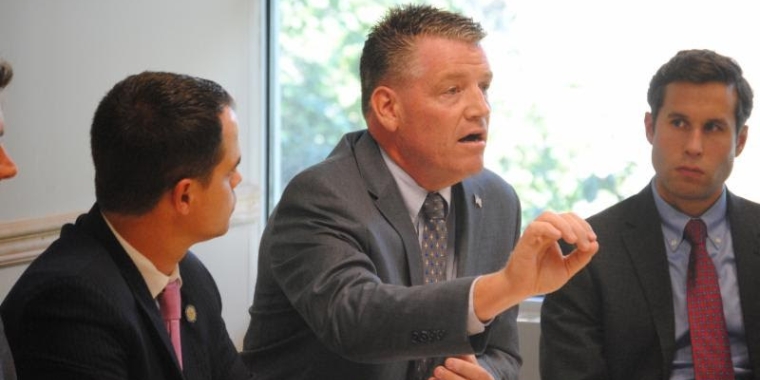Murphy cuts insurance red tape with landmark heroin legislation
December 30, 2016
-
COMMITTEE:
- Heroin Task Force

Albany, NY – Senator Terrence Murphy knows no one is immune to the rampant heroin epidemic enveloping our nation. This is most evident in Erie County, which has been hit with a wave of 42 opioid overdose deaths in December, including six alone on December 27th.
As Co-Chairman of the New York State Task Force on Heroin and Opioid Abuse, Senator Murphy has traveled throughout the state, talking with individuals and families, including many people who were unable to get treatment because of insurance constraints. To remedy this hardship, Senator Murphy has authored legislation to make it easier for people in need to get treatment. Senator Murphy’s landmark health insurance reforms will go into effect beginning January 1, 2017.
“This legislative package removes many of the burdensome insurance coverage barriers keeping people from treatment,” said Senator Murphy. “This legislation can turn hopelessness into hope by limiting prescriptions to opiates, cutting through the red tape of insurance authorization, and giving emergency medical technicians the tools they need to help save lives. It has been a deadly December in places like Erie County and on Long Island. This is why we need these initiatives, so we can help save lives in the future.”
“The legislative package sponsored by Senator Murphy and signed into law by Governor Cuomo shows that this administration is very pro-active in battling the heroin epidemic in New York State,” said Susan Salomone, President and Executive Director for Drug Crisis in Our Backyard. “We are confident that the decrease in pain medications on the street available to young people will make it more difficult for them to get addicted to opiates.”
Mel Berger, Chairman of the Mount Kisco Drug and Alcohol Abuse Prevention Council stated, “There is no such thing as a functioning heroin addict. They are either treated as a life or death medical necessity or considered as a victim of a society that chooses to ignore its obligation to provide the finest, most effective health care to its members. The passage of this legislation will help those who need it the most get back on the right path.”
“Too many lives have been lost and treatment has been delayed because people have had to jump through hoops in order to deal with insurance companies,” said Tom Diana, Yorktown Councilman and founder of Yorktown Against Heroin. “The focus should not be on filling out forms and making phone calls, it should be saving lives. This groundbreaking legislation will also have a positive effect on getting more dangerous drugs off the street.”
The legislative package includes several best practices and recommendations identified by Governor Cuomo’s Heroin and Opioid Task Force which Senator Murphy served on. These new insurance-related protections are the final components of the package to take effect and include four new measures to remove barriers for inpatient treatment and medication. The measures:
- Ending prior insurance authorization to allow for immediate access to treatment for substance use disorders for as long as an individual needs them. In addition, the legislation establishes that utilization review by insurers can begin only after the first 14 days of treatment, ensuring that every patient receives at least two weeks of uninterrupted care before the insurance company becomes involved.
- Ending prior insurance authorization to allow for greater access to drug treatment medications. Similar provisions took effect in June 2016 that also apply to managed care providers treating Medicaid recipients who seek access to buprenorphine and injectable naltrexone.
- All insurers operating in New York State must use objective, state-approved criteria when making coverage determinations for all substance use disorder treatment in order to make sure individuals get the treatment they need.
- Naloxone is one of the most effective medications used in the treatment of a suspected heroin overdose. Commonly referred to as Narcan, naloxone revives an individual from a heroin or opioid overdose and has saved thousands of lives. To make naloxone more accessible, the new legislation requires insurance companies to cover the costs of naloxone to a person who is addicted to opioids or their family member covered under the same insurance plan.
The new insurance coverage requirements apply to small group and large group plans regulated by the Department of Financial Services that are issued or renewed beginning January 1st, as well as plans sold to individual consumers. Other provisions in the legislative package already in effect include:
- Families can now seek 72-hours of emergency treatment, an increase from 48-hours, for their loved one so that they can be stabilized and connected to longer-term addiction treatment options.
- Hospital medical staff must provide discharge-planning services to connect patients who are at-risk for substance use disorder with nearby treatment options to provide continuous medical care.
- Trained professionals can now administer the life-saving overdose-reversal medication naloxone in emergency situations without risk to their professional license.
- The wraparound program launched in 2014 to provide services is now further expanded to support long-term recovery, and includes education and employment resources; legal services; social services; transportation assistance, childcare services; and peer support groups.
- Prescription limits for opioids for acute pain will be reduced from 30-days tono more than a 7-day supply, with exceptions for chronic pain and other conditions.
- Health care professionals must complete three hours of education every three years on addiction, pain management, and palliative care.
- Pharmacists must provide educational materials to consumers about the risk of addiction, including information about local treatment services.
- The State Commissioner of Health must report county-level data on opioid overdoses and usage of overdose-reversal medication on a quarterly basis.
Share this Article or Press Release
Newsroom
Go to NewsroomMTA issues update on Metro-North shuttles and train service
February 4, 2015
Statement on Metro-North tragedy in 40th district
February 4, 2015

